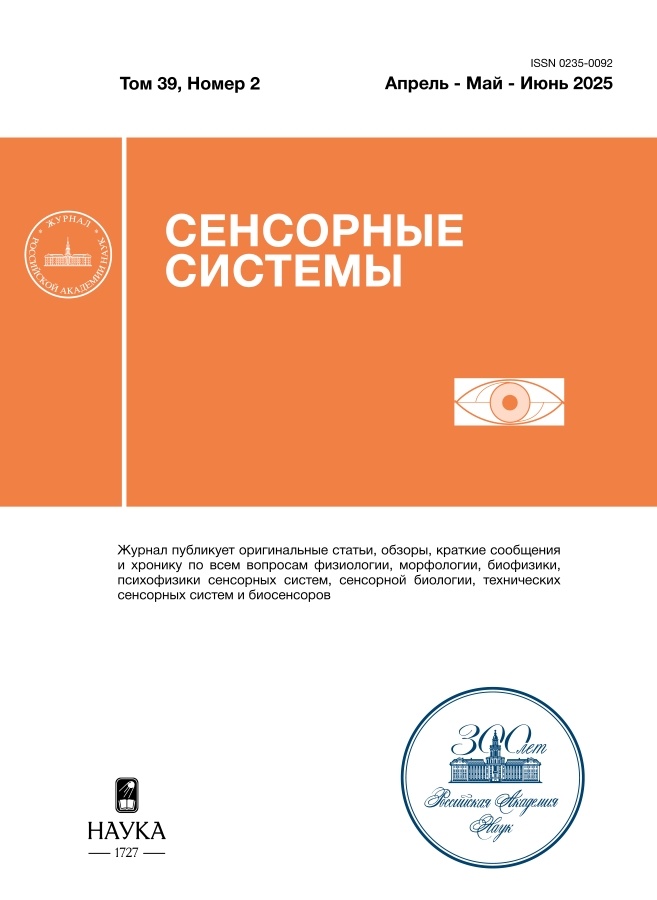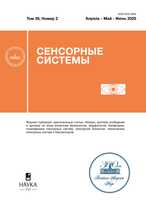Сенсорные системы
Журнал “Сенсорные системы” публикует оригинальные статьи, обзоры, краткие сообщения, рецензии на новые книги, информацию о конференциях. Назначение журнала – освещать физические, физиологические, морфологические и информационные аспекты структуры и функции биологических и технических сенсорных систем, принципы представления и переработки информации из окружающего мира и реконструкции его содержания, алгоритмы работы систем автоматического анализа сенсорной информации для управления аппаратами, заменяющими человека в разных сферах деятельности.
Свидетельство о регистрации СМИ: ПИ № ФС 77 – 66699 от 28.07.2016
Текущий выпуск
Том 39, № 2 (2025)
ОБЗОРЫ
Анализ развития компьютерных методов бинокулярного лечения косоглазия и амблиопии
Аннотация
Компьютерные методы начали активно внедряться в практику лечения косоглазия и амблиопии с 1990-х гг. В отечественной офтальмологии сразу возникло несколько независимых групп специалистов, создающих интерактивные компьютерные программы (ИКП) для диагностики и лечения указанных расстройств бинокулярного зрения. Это привело к появлению достаточно большого выбора ИКП и аппаратно-программных комплексов, различающихся по назначению, технологии сепарации левого и правого изображений и дизайну. Основными факторами, определяющими потенциал развития компьютерных методов, были и остаются успехи фундаментальных исследований зрительной системы, результаты использования уже созданных ИКП в практической работе и технические нововведения. Однако реализации этого потенциала мешает ряд маркетинговых и социальных факторов, затрудняющих обмен опытом между разными группами специалистов, разрабатывающих и применяющих ИКП, а также отсутствие теоретического обсуждения общей методологии, способов оптимизации и режимов использования различных ИКП. В связи с появлением принципиально новых данных, касающихся патогенеза и лечения амблиопии и возможности успешной активации давно заблокированных (“спящих”) механизмов бинокулярного стереопсиса у взрослых пациентов, остро ощущается необходимость пересмотра сложившейся ситуации. Мнения относительно эффективности компьютерных методов бинокулярной терапии (МБТ) противоречивы: одни исследователи дают очень высокие оценки, другие практически не видят от МБТ специфической пользы по сравнению с традиционными методами. В данной статье обозначен ряд причин, объясняющих отсутствие консенсуса: расплывчатость критериев принадлежности методов к “классу МБТ”, различия технических вариантов реализации МБТ, специфика зрительных стимулов и условий применения МБТ, различия групп пациентов и форм работы с ними (таких как обучение, инструктирование, помощь, поощрение, привлечение к выбору рабочего материала и др.). Обсуждаются требования к адекватному проведению экспертизы и сравнительной оценки результативности различных методов лечения расстройств бинокулярного зрения.
 3-44
3-44


От палочки до колбочки: функциональные переходы в эволюции фоторецепторов позвоночных
Аннотация
Сетчатка позвоночных содержит два типа фоторецепторов: палочки и колбочки, являющиеся рецепторами ночного и дневного зрения соответственно. Они имеют ряд морфологических и биохимических различий, определяющих их функциональную роль. Обнаружение у ряда позвоночных рецепторов промежуточного типа стало основой для теории трансмутаций, постулирующей, что как палочки, так и колбочки в процессе адаптации зрительной системы к различным условиям обитания способны менять свои функциональные роли и превращаться в противоположный своему тип. Можно выделить несколько уровней проявления изменений в физиологии фоторецептора при функциональном переходе: морфологический (общее строение клетки), молекулярно-биохимический (экспрессия специфичных изоформ белков светочувствительного сигнального каскада) и электрофизиологический (чувствительность и кинетика ответа на свет). Фоторецепторы с подтвержденным переходным типом обнаруживаются у наиболее примитивных позвоночных, а также у групп, претерпевших смещение условий обитания в сторону крайне низкой или высокой освещенности. В последние два десятилетия значительно продвинулось понимание молекулярных механизмов функционального перехода от типичных палочек к колбочкам, и наоборот. Вместе с тем ряд аспектов остается малоизученным, в первую очередь из-за того, что многие животные, обладающие переходными рецепторами, далеки от стандартных модельных объектов современной биологии. В рамках данного обзора рассматриваются примеры переходных фоторецепторов в различных таксонах, описывается история их изучения и современные исследования, проливающие свет на молекулярные особенности, лежащие в основе их нестандартной физиологии.
 45-74
45-74


ЗРИТЕЛЬНАЯ СИСТЕМА
Изменения электроретинограммы сложных глаз таракана Periplaneta americana L. при экранировании оцеллей
Аннотация
Зрительная система таракана включает сложные глаза с фоторецепторами двух спектральных классов и оцелли – простые глазки, состоящие из зеленочувствительных фоторецепторов. С помощью метода неинвазивной регистрации электроретинограммы (ЭРГ) от обоих сложных глаз показано, что экранирование оцеллей приводит к существенному изменению параметров ЭРГ, а именно к увеличению амплитуды ответов на коротковолновые стимулы насыщающей интенсивности и замедлению ответов как на коротковолновый, так и длинноволновый свет. Оцелли, оценивающие общий уровень освещенности, модулируют работу фоторецепторов сложных глаз ночью, в условиях низкой освещенности, увеличивая время суммации попадающего в глаз света для генерации ответа.
 75-87
75-87


СОМАТОСЕНСОРНАЯ СИСТЕМА
Влияние “сухой” иммерсии на характеристики выполнения зрительно-двигательной задачи с помощью джойстика в зависимости от направления движения руки
Аннотация
Вопросы, связанные с управлением движением руки в космическом полете (КП), являются крайне важными. От успешности выполнения операторской деятельности зависит безопасность КП. Для исследования влияния фактора КП (опорной разгрузки) используют наземную модель “сухой” иммерсии (СИ). Исследование проведено в условиях 7-суточной СИ. Во время выполнения зрительно-двигательной задачи перемещения курсора с помощью джойстика из центра экрана на одну из периферических мишеней, появляющихся в случайном порядке, у 10 испытуемых проведена оценка влияния СИ на параметры движения курсора в четырех направлениях. Показаны различия временных и точностных параметров выполнения задачи в зависимости от направления движения руки в контрольных исследованиях, которые сохраняются во время и после воздействия СИ. В первые дни СИ большинство оцениваемых параметров движения курсора ухудшались вне зависимости от направления, к концу иммерсии они восстанавливались. Степень воздействия СИ на параметры движения курсора отличалась в зависимости от направления движения руки и была максимально выражена в первые дни СИ. Минимальное воздействие СИ оказала на движение слева направо.
 88-99
88-99













